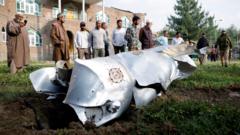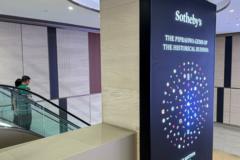**India and Pakistan escalate their military exchanges with drone incursions and retaliatory strikes, leaving the Kashmir conflict at a critical juncture.**
**Aerial Warfare Escalates Tensions Between India and Pakistan**

**Aerial Warfare Escalates Tensions Between India and Pakistan**
**As drone warfare intensifies, the longstanding conflict between two nuclear powers sees a new, dangerous chapter.**
In an unprecedented escalation of military conflict, India and Pakistan are engaging in a new phase of their long-standing animosity as they embrace drone warfare. Just this past Friday, reports emerged from Jammu, the Indian-controlled region of Kashmir, detailing a blackout and explosions, hinting at intensified hostilities between the two nuclear-armed nations.
Indian defense officials have reported that the Pakistani military attempted numerous aerial incursions, deploying between 300 to 400 drones across 36 locations to test the capabilities of India's air-defense systems. In comparison, the Pakistani military claimed responsibility for the downing of 25 Indian drones, targeting them over strategic cities including Karachi and Rawalpindi, home to critical intelligence agencies. Pakistani officials have characterized India's aerial maneuvers as “drone terrorism,” accusing them of endangering civilian lives. Meanwhile, India has refrained from addressing the drone allegations directly.
Historically, the incorporation of drones into military strategies is significant, as this is the first time that both India and Pakistan are utilizing unmanned aerial vehicles against one another. The adaptation signifies a possible shift in the perception of their conflict, reminiscent of international perspectives following their nuclear armament in the late 20th century.
This latest chapter was fueled by intensified tensions following a militant attack that left 26 individuals dead in Kashmir, with India accusing Pakistan of complicity. Responding to the tragedy, India executed aerial strikes on Pakistan, prompting a cycle of aggressive exchanges, culminating in heightened exchanges of gunfire, drone assaults, and a flood of misinformation.
The situation remains fluid, with both countries on high alert as they navigate this new frontier of warfare amidst an already fraught geopolitical landscape.
Indian defense officials have reported that the Pakistani military attempted numerous aerial incursions, deploying between 300 to 400 drones across 36 locations to test the capabilities of India's air-defense systems. In comparison, the Pakistani military claimed responsibility for the downing of 25 Indian drones, targeting them over strategic cities including Karachi and Rawalpindi, home to critical intelligence agencies. Pakistani officials have characterized India's aerial maneuvers as “drone terrorism,” accusing them of endangering civilian lives. Meanwhile, India has refrained from addressing the drone allegations directly.
Historically, the incorporation of drones into military strategies is significant, as this is the first time that both India and Pakistan are utilizing unmanned aerial vehicles against one another. The adaptation signifies a possible shift in the perception of their conflict, reminiscent of international perspectives following their nuclear armament in the late 20th century.
This latest chapter was fueled by intensified tensions following a militant attack that left 26 individuals dead in Kashmir, with India accusing Pakistan of complicity. Responding to the tragedy, India executed aerial strikes on Pakistan, prompting a cycle of aggressive exchanges, culminating in heightened exchanges of gunfire, drone assaults, and a flood of misinformation.
The situation remains fluid, with both countries on high alert as they navigate this new frontier of warfare amidst an already fraught geopolitical landscape.



















